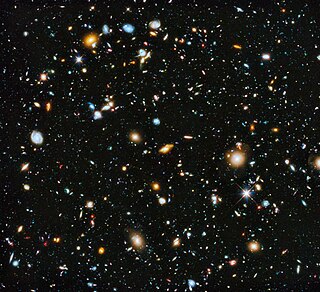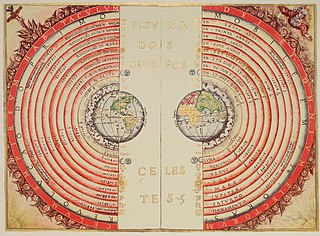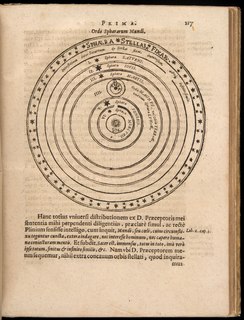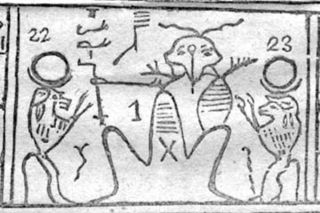
The following outline is provided as an overview of and topical guide to space science:

The Universe is all of space and time and their contents, including planets, stars, galaxies, and all other forms of matter and energy. While the spatial size of the entire Universe is unknown, it is possible to measure the observable universe.

The cosmos is the universe. Using the word cosmos rather than the word universe implies viewing the universe as a complex and orderly system or entity; the opposite of chaos.
The cosmos, and our understanding of the reasons for its existence and significance, are studied in cosmology – a very broad discipline covering any scientific, religious, or philosophical contemplation of the cosmos and its nature, or reasons for existing. Religious and philosophical approaches may include in their concepts of the cosmos various spiritual entities or other matters deemed to exist outside our physical universe.

Cosmogony is any model concerning the origin of either the cosmos or universe. Developing a complete theoretical model has implications in both the philosophy of science and epistemology.

Astronomy is a natural science that studies celestial objects and phenomena. It applies mathematics, physics, and chemistry in an effort to explain the origin of those objects and phenomena and their evolution. Objects of interest include planets, moons, stars, nebulae, galaxies, and comets; the phenomena also includes supernova explosions, gamma ray bursts, quasars, blazars, pulsars, and cosmic microwave background radiation. More generally, all phenomena that originate outside Earth's atmosphere are within the purview of astronomy. A related but distinct subject is physical cosmology, which is the study of the Universe as a whole.

This timeline of cosmological theories and discoveries is a chronological record of the development of humanity's understanding of the cosmos over the last two-plus millennia. Modern cosmological ideas follow the development of the scientific discipline of physical cosmology.

In astronomy, the geocentric model is a superseded description of the Universe with Earth at the center. Under the geocentric model, the Sun, Moon, stars, and planets all orbited Earth. The geocentric model served as the predominant description of the cosmos in many ancient civilizations, such as those of Aristotle and Ptolemy.

An astronomical object or celestial object is a naturally occurring physical entity, association, or structure that exists in the observable universe. In astronomy, the terms object and body are often used interchangeably. However, an astronomical body or celestial body is a single, tightly bound, contiguous entity, while an astronomical or celestial object is a complex, less cohesively bound structure, which may consist of multiple bodies or even other objects with substructures.

Plasma cosmology is a non-standard cosmology whose central postulate is that the dynamics of ionized gases and plasmas play important, if not dominant, roles in the physics of the universe beyond the Solar System. In contrast, the current observations and models of cosmologists and astrophysicists explain the formation, development, and evolution of astronomical bodies and large-scale structures in the universe as influenced by gravity and baryonic physics.

The celestial spheres, or celestial orbs, were the fundamental entities of the cosmological models developed by Plato, Eudoxus, Aristotle, Ptolemy, Copernicus, and others. In these celestial models, the apparent motions of the fixed stars and planets are accounted for by treating them as embedded in rotating spheres made of an aetherial, transparent fifth element (quintessence), like jewels set in orbs. Since it was believed that the fixed stars did not change their positions relative to one another, it was argued that they must be on the surface of a single starry sphere.

The fixed stars comprise the background of astronomical objects that appear to not move relative to each other in the night sky compared to the foreground of Solar System objects that do. Generally, the fixed stars are taken to include all stars other than the Sun. Nebulae and other deep-sky objects may also be counted among the fixed stars.

Andrei Dmitriyevich Linde is a Russian-American theoretical physicist and the Harald Trap Friis Professor of Physics at Stanford University. Linde is one of the main authors of the inflationary universe theory, as well as the theory of eternal inflation and inflationary multiverse. He received his Bachelor of Science degree from Moscow State University. In 1975, Linde was awarded a Ph.D. from the Lebedev Physical Institute in Moscow. He worked at CERN since 1989 and moved to the United States in 1990, where he became professor of physics at Stanford University. Among the various awards he has received for his work on inflation, in 2002 he was awarded the Dirac Medal, along with Alan Guth of MIT and Paul Steinhardt of Princeton University. In 2004 he received, along with Alan Guth, the Gruber Prize in Cosmology for the development of inflationary cosmology. In 2012 he, along with Alan Guth, was an inaugural awardee of the Fundamental Physics Prize. In 2014 he received the Kavli Prize in Astrophysics "for pioneering the theory of cosmic inflation", together with Alan Guth and Alexei Starobinsky. In 2018 he received the Gamow Prize.

Cosmology is a branch of astronomy concerned with the studies of the origin and evolution of the universe, from the Big Bang to today and on into the future. It is the scientific study of the origin, evolution, and eventual fate of the universe. Physical cosmology is the scientific study of the universe's origin, its large-scale structures and dynamics, and its ultimate fate, as well as the laws of science that govern these areas.
In Hindu cosmology, the universe is cyclically created and destroyed. Its cosmology divides time into four epochs or Yuga, of which the current period is the Kali Yuga.
Sufi cosmology is a Sufi approach to cosmology which discusses the creation of man and the universe, which according to mystics are the fundamental grounds upon which Islamic religious universe is based. According to Sufi cosmology, God's reason for the creation of this cosmos and humankind is the "manifestation" and "recognition" of Himself as it is stated in Hadith Qudsi – "I was a hidden Treasure; I desired to be recognized so I created the creature".

Greek astronomy is astronomy written in the Greek language in classical antiquity. Greek astronomy is understood to include the ancient Greek, Hellenistic, Greco-Roman, and Late Antiquity eras. It is not limited geographically to Greece or to ethnic Greeks, as the Greek language had become the language of scholarship throughout the Hellenistic world following the conquests of Alexander. This phase of Greek astronomy is also known as Hellenistic astronomy, while the pre-Hellenistic phase is known as Classical Greek astronomy. During the Hellenistic and Roman periods, much of the Greek and non-Greek astronomers working in the Greek tradition studied at the Musaeum and the Library of Alexandria in Ptolemaic Egypt.
Islamic cosmology is the cosmology of Islamic societies. It is mainly derived from the Qur'an, Hadith, Sunnah, and current Islamic as well as other pre-Islamic sources. The Qur'an itself mentions seven heavens.

Philosophical cosmology, philosophy of cosmology or philosophy of cosmos is a discipline directed to the philosophical contemplation of the universe as a totality, and to its conceptual foundations. It draws on several branches of philosophy—metaphysics, epistemology, philosophy of physics, philosophy of science, philosophy of mathematics, and on the fundamental theories of physics. The term cosmology was used at least as early as 1730, by German philosopher Christian Wolff, in Cosmologia Generalis.
















